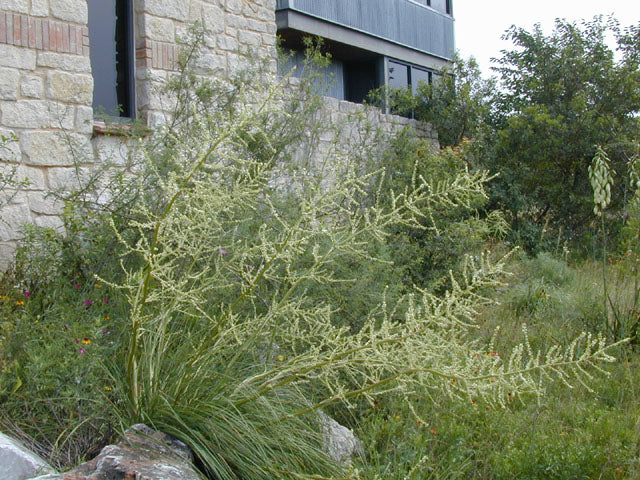Lindheimer's Nolina (Nolina lindheimeriana)
Lindheimer's Nolina (Nolina lindheimeriana)
Low stock: 3 left
Couldn't load pickup availability
Nolina lindheimeriana (Scheele) S. Watson
Devil's Shoestring, Devil's-shoestring, Ribbon Grass
Liliaceae (Lily Family)
Synonym(s):
USDA Symbol: NOLI
Resembling a large clump of grass in the open and in light shade on limestone slopes and cliffs. Stem usually single, herbaceous, from a woody underground base. Leaves arising from the ground line or form the lower part of the stem, long, flat, and narrow, up to 30 inches long by 5/16 inch wide, with finely serrated margins, teeth visible under a 10x hand lens. Flowers about 3/16 inch wide, white to cream, numerous on slender branches from the upper part of the rather tall stem and forming a loose, open display 1 to 3 feet or more tall and several inches wide, opening in spring and early summer. Fruit a short capsule about 3/16 inch wide.
This species is named after Ferdinand Jacob Lindheimer (1801-1879) who is often called the Father of Texas Botany because of his work as the first permanent-resident plant collector in Texas. In 1834 Lindheimer immigrated to the United States as a political refugee. He spent from 1843-1852 collecting specimens in Texas. In 1844 he settled in New Braunfels, Texas, and was granted land on the banks of the Comal River, where he continued his plant collecting and attempted to establish a botanical garden. He shared his findings with many others who shared his interest in botany, including Ferdinand von Roemer and Adolph Scheele. Lindheimer is credited with the discovery of several hundred plant species. In addition his name is used to designate forty-eight species and subspecies of plants. He is buried in New Braunfels. His house, on Comal Street in New Braunfels, is now a museum.
Plant Characteristics
Habit: Shrub
Leaf Retention: Evergreen
Leaf Complexity: Simple
Fruit Type: Capsule
Size Notes: Up to about 3 feet tall.
Flower: Flowers in 16 inch head.
Bloom Time: Apr , May , Jun
Distribution
USA: TX
Native Habitat: Prairie, Plains, Meadows, Pastures, Savannas, Chaparral & brush country
Growing Conditions
Water Use: Low
Light Requirement: Sun , Part Shade
Soil Moisture: Dry
Cold Tolerant: yes
Heat Tolerant: yes
Soil Description: Sandy, Sandy Loam, Medium Loam, Clay Loam, Clay, Limestone-based, Caliche type
Conditions Comments: This highly ornamental species forms a graceful rosette of narrow, rich green leaves. In late spring, it throws up several large spikesof yellow green flowers that transform into rows of attractive, papery seed capsules. This plant is extremely drought tolerant.
Benefit
Use Ornamental: Accent tree or shrub, Winter-hardy
Conspicuous Flowers: yes
Interesting Foliage: yes
Deer Resistant: High
Image Information
Photographer: Marcus, Joseph A.City: Austin
County: Travis
State: TX
Location Notes: Lady Bird Johnson Wildflower Center. Grotto Terraces West.
Accession date: 2003-10-01
Filename: 6151_IMG02849.JPG
Slide Index: Not Applicable
Restrictions: Unrestricted
Collection: Wildflower Center Digital Library
Original Format: Digital
Orientation: Landscape
Shot: Whole Plant(s)
Date Taken: 2003
NPIN Image Id: 13877


